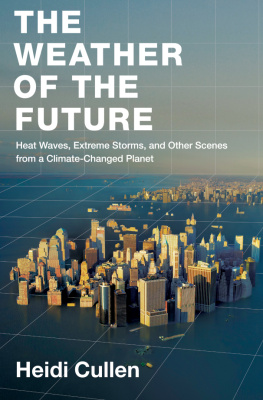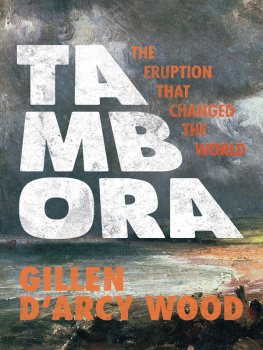
TAMBORA
TAMBORA
THE ERUPTION THAT CHANGED THE WORLD
GILLEN DARCY WOOD
PRINCETON UNIVERSITY PRESS
PRINCETON AND OXFORD
Copyright 2014 by Princeton University Press
Published by Princeton University Press, 41 William Street, Princeton, New Jersey 08540
In the United Kingdom: Princeton University Press, 6 Oxford Street, Woodstock, Oxfordshire OX20 1TW
press.princeton.edu
Jacket Art: Weymouth Bay, 1816 (oil on canvas), John Constable (17761837). Location: The Victoria & Albert Museum, London, UK. Courtesy of The Bridgeman Art Library.
All Rights Reserved
Library of Congress Cataloging-in-Publication Data
Wood, Gillen DArcy.
Tambora : the eruption that changed the world / Gillen DArcy Wood.
pages cm
Includes bibliographical references and index.
ISBN 978-0-691-15054-3 (hardcover : acid-free paper) 1. Tambora, Mount (Indonesia)Eruption, 1815. 2. WeatherEffect of volcanic eruptions onHistory19th century. 3. VolcanoesEnvironmental aspectsHistory19th century. 4. ClimatologyObservationsHistory19th century. I. Title.
QC981.8.V65W66 2014
363.3495dc23
2013021152
British Library Cataloging-in-Publication Data is available
This book has been composed in Sabon Next LT Pro
Printed on acid-free paper.
Printed in the United States of America
10 9 8 7 6 5 4 3 2 1
To the memory of Bess, Linnell, Monica, and Bessie
And to Nancy, and a climate-stable future for our children
A fearful hope was all the world contained
The brows of men by the despairing light
Wore an unearthly aspect, as by fits
The flashes fell upon them; some lay down
And hid their eyes and wept
And others hurried to and fro, and fed
Their funeral piles with fuel, and looked up
With mad disquietude on the dull sky,
The pall of a past world
LORD BYRON, DARKNESS (1816)
ILLUSTRATIONS
FIGURES
FIGURE 0.1
Map of global sulfate deposition 3
FIGURE 0.2
Caspar David Friedrich, Ships in the Harbor (1816) 4
FIGURE 0.3
Tambora caldera 6
FIGURE 0.4
Tambora caldera (aerial view) 7
FIGURE 1.1
Map of the East Indies (nineteenth century) 13
FIGURE 1.2
Map of Sumbawa 14
FIGURE 1.3
Diagram of plinian explosion and pyroclastic flow 19
FIGURE 1.4
Tambora eruption timeline 22
FIGURE 1.5
Map of Tambora ash fallout 23
FIGURE 1.6
Artifacts recovered from Tambora village 26
FIGURE 1.7
Portrait of Sir Stamford Raffles (1817) 28
FIGURE 1.8
Javan landscape (nineteenth century) 31
FIGURE 2.1
J.M.W. Turner, Mt. Vesuvius in Eruption (1812) 35
FIGURE 2.2
Sulfate deposition in ice core samples showing 1809 and 1815 eruptions 38
FIGURE 3.1
Portrait copy of Mary Shelley (1816) 47
FIGURE 3.2
Portrait of Percy Bysshe Shelley (1819) 47
FIGURE 3.3
Diagram showing creation of volcanic sulfate aerosols 48
FIGURE 3.4
John Constable, Weymouth Bay (1816) 50
FIGURE 3.5
Annual frequency of gale days at Edinburgh (17891988) 53
FIGURE 3.6
Lord Byron at the Villa Diodati 68
FIGURE 4.1
Historical map of north-central India, scene of Lord Hastingss Maratha campaign and the cholera outbreak of November 1817 73
FIGURE 4.2
A View of Erich above the River Betwah (1817) 76
FIGURE 4.3
Synoptic map of South Asian monsoon 80
FIGURE 4.4
William Hodges, The Ghauts at Benares (1787) 85
FIGURE 4.5
James Baillie Fraser, Calcutta Bazaar (182426) 91
FIGURE 4.6
Map of global cholera spread (nineteenth century) 92
FIGURE 5.1
Map of China agriculture (Qing dynasty) 100
FIGURE 5.2
Chinese rice fields (mid-1840s) 103
FIGURE 5.3
Chinese mother bringing her children to market for sale (mid-1870s) 112
FIGURE 5.4
Chinese opium den (mid-1840s) 118
FIGURE 6.1
Portrait of Sir John Barrow (circa 1810) 124
FIGURE 6.2
Portrait of William Scoresby Jr. (1821) 126
FIGURE 6.3
Scoresbys Marine Diver 136
FIGURE 6.4
Map showing global thermohaline circulation 137
FIGURE 6.5
Global drought postPinatubo eruption 139
FIGURE 6.6
Portrait of Captain William Edward Parry (1820) 143
FIGURE 6.7
Discovery of Franklin expedition remains (1861) 145
FIGURE 7.1
J.M.W. Turner, Mer de Glace (1812) 156
FIGURE 7.2
Portrait of Ignace Venetz (1826) 158
FIGURE 7.3
Map of Val de Bagnes and Gitro glacier dam, 1818 160
FIGURE 8.1
The Black Prophet (title page) 175
FIGURE 8.2
Synoptic map of low-pressure system over British Isles, July 1816 177
FIGURE 8.3
Diagram showing typhus transmission 184
FIGURE 8.4
Illustration, The Black Prophet 196
FIGURE 9.1
Map of New England snowline, June 67, 1816 202
FIGURE 9.2
Historical graph, New England growing seasons 204
FIGURE 9.3
Portrait of Thomas Jefferson (1821) 207
FIGURE 9.4
Portrait of Comte de Buffon (1753) 208
FIGURE 9.5
Transatlantic grain prices, post-Tambora period 222
FIGURE 9.6
View of Monticello (1825) 223
FIGURE E.1
Nicolas Poussin, Et in Arcadia Ego (1639) 232
NOTE ON MEASUREMENTS
This book deals much with science and the history of science, but I have not maintained a scientific adherence to metrical units of measurement. Instead I have been guided principally by context. Where the historical or cultural setting seems appropriate, I have used imperial measures of distance as well as the Fahrenheit temperature scale.
TAMBORA
INTRODUCTION
FRANKENSTEINS WEATHER
The War of Independence between Britain and America provisionally ended with the Treaty of Paris in December 1783. But official ratification of the peace accord was delayed for months by a mix of political logistics and persistent bad weather. The makeshift U.S. capital in Annapolis, Maryland, was snowbound, preventing assembly of congressional delegates to ratify the treaty, while storms and ice across the Atlantic slowed communications between the two governments. At last, on May 13, 1784, Benjamin Franklin, wrangling matters in Paris, was able to send the treaty, signed by King George himself, to the Congress.
Even while scrambling to bring the warring parties to terms, Franklintireless and mercurialfound time to reflect on the altered climate of 178384 that had played such a complicating role in recent events. There seems to be a region high in the air over all countries where it is always winter, he wrote. But perhaps the universal fog and cold that had descended from the atmosphere to blanket all Europe might be attributed to volcanic activity, specifically an eruption in nearby Iceland.
Franklins Meteorological Imaginations and Conjectures amounts to no more than a few pages of disconnected thoughts, scribbled amid a high-stakes diplomatic drama. The papers unlikely fame as a scientific document rests on its being the first published speculation on the link between volcanism and extreme weather. Franklin hastily sent his paper on meteorology to Manchester, where the local Philosophical Society had awarded him honorary membership. On December 22, 1784, the president of the society rose to speak on Franklins behalf. No doubt dismayed at the papers thinness, he had no choice but to read the conjectures of the societys celebrated new member to the crowded assembly. There, in a freezing Manchester public hall, the theory that volcanic eruptions are capable of wreaking climate havoc was given its first public utterance.
Next page


















